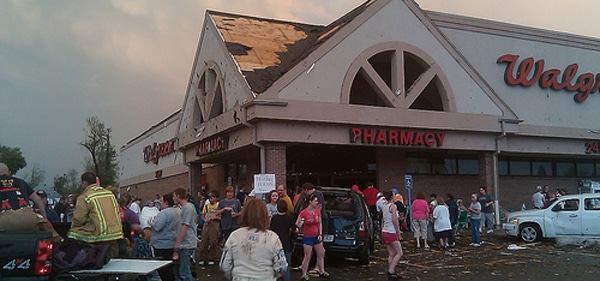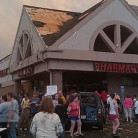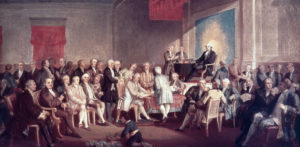-
 play_arrow
play_arrow
The CRUSADE Radio Network CRUSADE Radio Network
-
 play_arrow
play_arrow
PREVIEW: Bongino and Patel Detail Progress Mike "The KingDude" Church
-
 play_arrow
play_arrow
Audio Post Format TheKingDude

-
 play_arrow
play_arrow
A Tale of Two Tornadoes ClintStroman
Podcast: Play in new window | Download | Embed
Mandeville, LA – Exclusive Audio & Transcript – Joplin and Tuscaloosa, two cities that suffered from two of the worst tornado disasters in American history, have taken radically different approaches to the rebuilding of their cities. Tuscaloosa is taking a top down approach, attempting to centrally plan out it’s recovery. Whereas Joplin, which got hit harder, is taking the bottom up, business friendly approach. Now, which one do you think is working faster and better and which one do you think is stalling and keeping businesses from re-building? Check out today’s audio and transcript for the answers.
-
 play_arrow
play_arrow
A Tale of Two Tornadoes ClintStroman
Begin Mike Church Show Transcript
[reading]
Last April 27th, one of the worst tornadoes in American history tore through Tuscaloosa, Alabama killing 52 people and damaging or destroying 2,000 buildings. In six minutes, it put nearly one-tenth of the city’s population into the unemployment line. A month later, Joplin, Missouri suffered an even more devastating blow. In a city with half the population of Tuscaloosa, a tornado killed 161 and damaged or destroyed more than 6,000 buildings.
More than 100,000 volunteers mobilized to help the stricken cities recover. A “can-do” spirit took hold, with churches, college fraternities and talk-radio stations leading the way. A year after the tragedies, that spirit lives on far more in Joplin than in Tuscaloosa. Joplin is enjoying a renaissance while Tuscaloosa’s recovery has stalled. [Mike: Gee, do you smell government? I smell government.]
In Joplin, eight of ten affected businesses have reopened, according to the city’s Chamber of Commerce, while less than half in Tuscaloosa have even applied for building permits, according to the city date we reviewed. Walgreens revived its Joplin store in what it calls a “record-setting” three months. In Tuscaloosa, a destroyed CVS still festers, undemolished. Large swaths of Tuscaloosa’s main commercial thoroughfares remain vacant lots, and several destroyed businesses have decided to reopen elsewhere, in neighboring Northport.
The reason for Joplin’s successes and Tuscaloosa’s shortcomings? In Tuscaloosa, officials sought to remake the urban landscape top-down, imposing a redevelopment plan on businesses.
[end reading]
Mike: That’s right. Government knows best. You dimwitted, nitwitted imbeciles out there that want to rebuild using your stupid free markets, you need to sit down and take notes. We’ll show you how we do it in government.
[reading]
Joplin took a bottom-up approach, allowing businesses to take the lead in recovery. “Out of the heartbreak of disaster,” declared Tuscaloosa Mayor Walt Maddox several days after his city’s tornado, “rises an extraordinary opportunity to comprehensively plan and rebuild our great city better than ever before.” In this transformative spirit, Tuscaloosa’s city council imposed a 90-day construction moratorium in the disaster area, restricting commercial and residential redevelopment until officials could craft and adopt a long-term master plan. Many of the restrictions remained long after the moratorium officially expired. Joplin, by contrast, passed a 60-day moratorium that applied only to single-family residential structures and was lifted on a rolling basis, as each section of the city saw its debris cleared, within 60 days.
The Alabama city’s recovery plan, “Tuscaloosa Forward,” is indeed state-of-the-art urban planning—and that’s the crux of the problem. It sets out to “courageously create a showpiece” of “unique neighborhoods that are healthy, safe, accessible, connected, and [Mike: There’s that damn word again] sustainable,” all anchored by “village centers” for shopping. Another goal is to “preserve neighborhood character” from a “disproportionate ratio of renters to owners.” [Mike: How are you going to accomplish that without subsidizing it and creating a housing bubble?] The plan never mentions protecting property rights.
In Joplin, the official plan not only makes property rights a priority but clocks in at only 21 pages, compared with Tuscaloosa’s 128. [Mike: Do you people see any pattern here? I am.] Joplin’s plan also relied heavily on input from businesses (including through a Citizen’s Advisory Recovery Team) instead of Tuscaloosa’s reliance on outside consulting firms and experts.
[end reading]
Mike: You see there? Finally an expert is given a chance to be experty in something and to get in there and expertalize all the expertedness that needs to be experted on the people. And what do they do? [mocking] “Well, we’ve gotta have a one-size-fits-all cookie cutter. Wait a minute. We get to make the rules around here.” You know what’s really, really informative of this? Even in small spheres, central economic planning does not work. It is impossible.
How many of you have ever built anything? It doesn’t matter what it is. Maybe you even built something and you started with a set of plans. You threw the plans out there and went and bought some materials and you started building it. All of a sudden, you’re looking and wait a minute, that’s not going to work there. It can’t work there. I’m going to have to adjust that. It can’t be two feet. They must have made a mistake. It should be three feet. Or that shouldn’t be that high, it should be there. Or that shouldn’t be there. That’s out of whack. That’s not going to work. That door shouldn’t be there; it should swing the other way.
My point would be that when you’re doing the work, you have a plan, a central plan. Even though it looks really good on paper, when you actually get out there and start sawing 2x4s and 2x6s and start running wires and what have you, it doesn’t work the same way in the field. You have to have the ability to be able to ad lib. You have to be able to call an audible, to put it in football terms. You can’t call audibles when government has planned the project and is calling the shots. Then you’ve got to go back to the agency, back to get a vote. [mocking] “This isn’t working out so well.” “You have to wait till next year to get on the docket.” “Well, I can’t wait till next year to get on the docket.” “Well that’s too bad.” “Well screw you!” That’s how it works.
[reading]
Joplin’s plan also relied heavily on input from businesses instead of Tuscaloosa’s reliance on outside consulting firms. “We need to say to our businesses, community, and our citizens, ‘If you guys want to rebuild your houses, we’ll do everything we can to make it happen,’” said Joplin City Council member William Scearce in an interview. Instead of encouraging businesses to rebuild as quickly as possible, Tuscaloosa enforced restrictive zoning rules and building codes that raised costs.
[end reading]
Mike: Sounds like Obama and Geithner got in there and rolled their sleeves up and went down to Alabama. [singing to the tune Devil Went Down to Georgia: Obama went down to Alabama, he was looking for a house to steal. He was in a bind, he was way behind.]
[reading]
John Carney, owner of Express Oil Change, which was annihilated by the storm, estimates that the city’s delays and regulation will cost him nearly $100,000. And trying to follow the rules often yielded mountains of red tape, as the city rejected businesses’ proposals one after another. “It’s just been a hodgepodge,” says Mr. Carney. “We’ve gotten so many mixed signals from the get go. The plans have been ever-changing.” Boulevard Salon owner Tommy Metrock, one of the few business owners to rebuild on Tuscaloosa’s main thoroughfare, McFarland Boulevard, says the restrictions created “chaos” as people put their livelihoods on hold while the city planned.
[end reading]
Mike: You can read the entire article posted in today’s Pile of Prep. Professor Beito concludes:
[reading]
Last year’s decentralized volunteer response seems to be entirely forgotten by the City of Tuscaloosa and it’s officialdom. As Mayor Maddox recently said: If Tuscaloosa “had a trained FEMA corps on the ground” when the tornado struck, “they could have taken over organizing the volunteers immediately.” [Mike: That’s right, you need FEMA to get in there and spend boatloads of federal money.]
In an age of mounting deficits and limited federal attention spans, hoping for more subsidies from Washington, D.C. [Mike: Mordor on the Potomac River] is a risky bet at bet at best. Joplin’s safer wager is in the good sense and independently generated resources of those individuals and businesses most directly affected by nature’s fury.
[end reading]
Mike: You know what else is just screaming to get out here in any conversation like this, and it is that Speaker Gingrich was fond of talking about how you can job out the eVerify system to Visa or MasterCard because they process billions of transactions every year and they hardly ever screw up and statements go out in time and all that stuff. In other words, the private sector has figured out ways to do these things, as the free markets and the private markets often do. They always do. That’s what makes a market. That’s what makes it unique and what makes it preferable. If the need is to rebuild, then the private sector will figure out a way to do it or the market will figure out a way to do it. If it can’t figure out a way to do it, then it’s probably because it didn’t need to be rebuilt, or in this instance it did. Even in small spheres like this, you’ll see that local central economic planning can screw things up, too. It doesn’t always have to be leviathan.
This is why you have to be an active little ‘r’ republican. You have to get in there and roll your sleeves up. You have to try and stop government at all levels from interfering. There’s not a thing in the building code that cannot be done by a private entity, not a thing. Electrical inspections, you can get private entities. Insurance companies could require. All the state would have to do, in other words, is say you’ve got to have this insurance, that insurance and that insurance and then you can be in business. That’s the end of the law. Then the market takes care of the rest. The insurance companies are going to have to certify that your home, business or whatever is safe. How are they going to do that? They’ll have the 2012 equivalent of Underwriters Laboratory or Consumer Reports or whatever the case may be. There’s always a way, folks. A market will find a way.
End Mike Church Show Transcript
Written by: ClintStroman
Similar posts
Featured post
Latest posts

The War Power To Take Out Cartels: Letters of Marque & Reprisal-Mike’s 2014 LPAC Speech

Brad Birzer and Winston Elliott Discuss “A New Dark Age”

Trump Should Read Thomas Jefferson’s First Inaugural Speech

Kamala Harris: The Shape Of Modern Evil, A Halloween Commentary
Mike Church Show- Review of 2016 Al Smith Dinner That Invited Killary
Current show
Upcoming shows
Mike Church Show Weekend Best Of
12:00 am - 11:59 pm
Condimentum Elit
11:40 pm - 11:55 pm
Chart
HERE IT GOES YOUR COPYRIGHT TEXT. CAN ALSO CONTAIN LINKS LIKE THIS







Post comments (0)